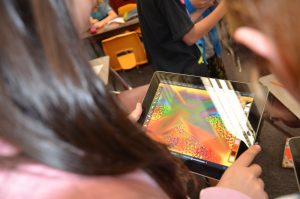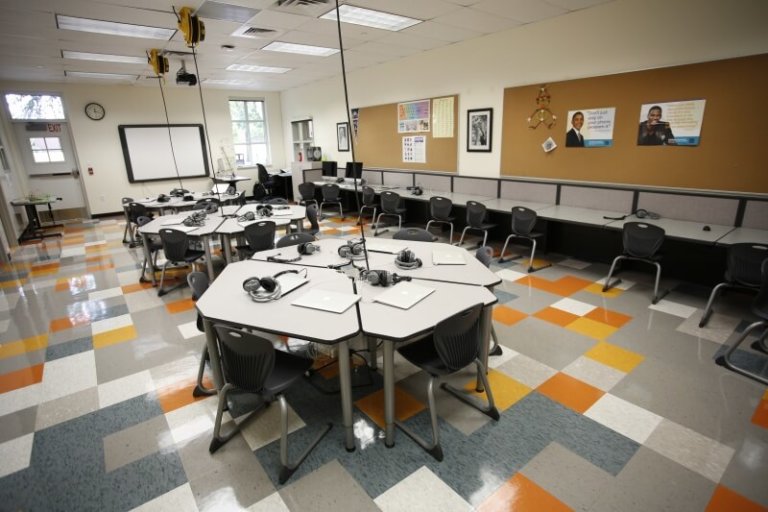 Not to give away the punchline in the first sentence, but I think we all know the answer to this one. Technology is the “frenemy” that we love most of the time, but despise at others. It is also a debate that has been written about so widely, that I hesitate to wade in; still, I believe that every school and family must consider carefully how to come to terms with iPads, cell phones, screens, and social media for the health of the community and of each child.
Not to give away the punchline in the first sentence, but I think we all know the answer to this one. Technology is the “frenemy” that we love most of the time, but despise at others. It is also a debate that has been written about so widely, that I hesitate to wade in; still, I believe that every school and family must consider carefully how to come to terms with iPads, cell phones, screens, and social media for the health of the community and of each child.
Unquestionably, there are incredibly positive uses for technology. I was observing one of our teachers seamlessly weaving Socratic discussion with real time screen casting of a student experiment.
The interplay of thoughtful conversation and slow motion, stop video of the student experiment allowed the class to dissect what actually happened in real time, creating a powerful learning moment, one I believe uniquely enabled this class to better understand Newton’s 2nd Law of Motion — no small thing. Could this have happened without the technology assist?
Maybe, but I would argue it would not have been as convincing or as “sticky” for the kids involved. Equally valid, I see many students successfully manage multiple demands because they are adept at supplementing their organizational skills with the iPad calendar and features available on the CA website. For students with executive function challenges, these assists are not secondary. In some cases, these reminders and organizational cues allow them to demonstrate what they know rather than trip over their organizational shortcomings. Could some of this be supported the old fashioned way with an assignment book and a paper calendar? Maybe, but only at the cost of a significant time commitment.
Moreover, my paper calendar never vibrated in my pocket to remind me that it was time to start studying. It also didn’t collect all of my major assessments for the month at a keystroke. The same can be said for writing. Paper and pencil (or quill) have done pretty well for humanity over the last 1,000 years. Why do we need to keyboard our thoughts particularly if it means that good penmanship becomes as rare as an uncrowded lane on I-25? Still, the argument for keyboarding is powerful when it comes to young people. Asking a middle schooler to willingly rewrite, arguably the most important step in the writing process, is a non-starter for many young people if it means copying by hand what has been painstakingly quilled. With an iPad, inserting text, moving or adding paragraphs and spell-checking is a breeze, leading to much improved expression of ideas.
Creative expression also sits in the “win” column when it comes to technology. I have been dazzled by students’ ability to use the power of the iPad to express their ideas in multi disciplinary and multi-modal ways. This is a “candy store” for kids who can weave together text, audio, photography, and videos. Asking kids to use poster board seems profoundly limiting. This short list barely scratches the surface of the ways technology can be effectively used to enhance student learning. We haven’t even touched upon the ability to connect people, research, discover, explore or evaluate knowledge or how students can collaborate from anywhere as if they were sitting shoulder to shoulder. As a school, we are believers that technology can enhance learning, that all students need to be facile users, AND that it should only be used when it is the most effective tool. Just as often, the skill we most want to cultivate in our middle schoolers is the ability to share ideas, listen empathetically, evaluate information, and learn in a face-to-face environment.
And, of course, there is the other side of the coin. Perhaps you had the chance to read the recent article, “How Smartphones Hijack Our Minds” by Nicholas Carr in The Wall Street
Journal, October 6. Depressing is mild for how it left me feeling (of course, ironically, I was reading it on a computer screen!). In it Carr posits that the relationship between the cell phone and its user is unique in history and that more and more evidence is stacking up that using the device undermines our health, skills, and powers of discernment. The myriad ills he explored included that the cell phone can:
- Foster anxiety and undermine performance
- Impede personal connection
- Make it more likely that new information is not internalized
- Encourage us to feel smarter than we actually are
While I could go into detail on each of these findings, instead, I will share two tidbits he highlighted. A University of California/San Diego study found that in an assessment of fluid intelligence, students who had a cell phone on their desk did significantly more poorly than students who left their phones in their lockers. The very presence of the phone in a students’ pocket — even if it was untouched — had a deleterious effect. A different University of Essex study he cited was intended to measure empathy, affinity and trust. It determined that for students, “The mere presence of mobile phones inhibited the development of interpersonal closeness and trust.” (Carr, “How Smartphones,” 2017)
In my little world inhabited by 200 plus Sixth, Seventh, and Eighth Graders I am even more concerned about social media and its ability to replace face-to-face contact or, more generally, to do harm. While this is far from a scientific double-blind study, my anecdotal evidence suggests that over 50% of the time when I intervene in a disciplinary way with students, it involves some aspect of cyber unkindness. In other words, the situation I am “unpacking” at school has either originated or was accelerated outside of school using a cell phone and social media.
I do not tend to tilt at windmills. The genie is out of the bottle. Cell phones are going to be a frenemy with lasting power for us and for our kids. I do think, though, that the steps the school has taken this year to make the Middle School and the dining hall a “no phone” zone is important.
Similarly, we will continue to make efforts as teachers to monitor how we define “best use” of technology in class and continue to privilege discussion and face-to-face interaction. On the parent side, I believe there is real reason to limit children’s access to the cell phone and social media. This includes creating “no phone” zones and times as well as a resting place for the phone each evening that is far away from the child’s bedroom. I also urge parents to consistently monitor text and email traffic and to delete apps that either deliver information anonymously or make the text “disappear” after it is read. The temptation to be unkind or inappropriate is simply too great.
Nothing I have written here is particularly new. It is important, though, as we come together in the CA community to educate a generation of kind and courageous young people.
Thoughtful use and rules surrounding technology at home and school is common sense. Yes, your child WILL say that you are the ONLY one taking a stand in these ways. Most often, though, this means that you are doing a good job of being a parent.
